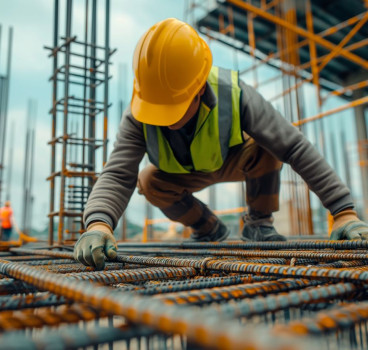The small innovations helping to transform construction
Construction’s biggest stories tend to revolve around landmark buildings, major digital breakthroughs, or the occasional crisis that pushes the industry into the headlines. Yet much of the sector’s real progress happens quietly. It’s found in modest but clever innovations that do not attract national attention, but steadily reshape how projects are delivered day by day. These are the products that reduce time on site, the digital processes that remove friction between teams and the methods that cut waste or risk without requiring huge investment. They rarely feature in keynote speeches or glossy marketing campaigns, but they are what many contractors rely on to improve performance and margins in a difficult market, writes John Ridgeway.
Many of the biggest improvements in construction efficiency and durability do not come from radical new systems, but from incremental advances in everyday materials. Adhesives with faster curing times, for example, have quietly transformed interior fit-out sequencing by reducing downtime between trades. Lightweight acoustic boards that offer higher performance at thinner profiles help designers meet both regulatory and spatial requirements without complicating installation. Even small improvements in fixings, anchor systems or jointing compounds can produce measurable changes in programme duration and snagging rates.
These material innovations rarely make headlines because they do not look revolutionary. Yet they steadily support higher-quality construction. A fixing that eliminates the need for pre-drilling or a board that cuts cleanly without dust extraction may not appear transformative, but multiplied across hundreds of installations on a project, the time savings and health benefits are significant. These developments also tend to be embraced more quickly than major technological shifts because they integrate seamlessly into existing workflows.
Digital tools that reduce friction
While digital transformation is often associated with big-ticket systems, such as BIM platforms, digital twins or AI-enabled modelling, many of the most helpful digital innovations are small tools that address specific pain points. Simple defect-reporting apps, for instance, have drastically reduced the time spent compiling snagging lists and eliminated confusion over version control. Cloud-based drawing viewers allow site teams to access current information without hunting through outdated paper prints, reducing errors and rework.
Even modest automations, such as auto-populating asset registers or linking site photographs to location markers, can make a material difference to project handover quality. These tools don’t demand major cultural change or heavy investment. Instead, they quietly streamline tasks that have long absorbed time and created inconsistencies. They also help digital adoption feel less daunting by showing immediate, practical benefits rather than abstract promises of future efficiency.
One of the most important sources of innovation in construction is safety and here too the biggest impact often comes from small design improvements. Ladder attachments that reduce slip risks, cut-resistant gloves made from thinner materials that improve dexterity, and compact dust extraction accessories for handheld tools all help reduce incidents without altering how people work.
These innovations succeed because they fit into familiar routines. A redesigned blade guard or a tethered fixing that prevents dropped tools can be adopted without retraining and without slowing progress. As a result, safety innovations that look minor on paper often achieve higher adoption rates than more radical alternatives. Cumulatively, they contribute to safer sites, fewer delays and less unproductive time caused by incidents or near misses.
Offsite manufacturing often dominates the conversation around modern methods of construction, yet many contractors are seeing valuable benefits from modular components that sit somewhere between full prefabrication and traditional site-built elements. Preassembled service risers, for example, reduce coordination issues and remove some of the highest-risk site activities. Pre-cut and pre-labelled cable kits simplify electrical installations and reduce waste. Modular bathroom pods or pre-formed door sets help maintain quality on large-scale residential or hotel projects where repetition is high.
These components avoid the logistical demands of whole-building offsite construction while still capturing many of its benefits. Their advantages accumulate quietly with fewer errors, faster installation, reduced waste and more predictable sequencing. For many contractors, these targeted modular solutions are more practical and scalable than adopting complete offsite construction across a project.
Environmental gains from subtle changes in product design
Sustainability in construction is often framed around headline technologies like heat pumps, photovoltaic systems or low-carbon concrete. But there is another side to the story - the environmental improvements made through incremental product changes that reduce waste, energy use or embodied carbon.
Manufacturers have introduced insulation materials with higher thermal performance using thinner profiles, contributing to more energy-efficient buildings without complicating design. Timber products with improved moisture resistance increase longevity and reduce rework. Recycled-content plasterboard and metal components quietly lower the embodied carbon of projects without requiring redesign. Even packaging improvements, such as stackable pallets, reusable crates or reduced plastic wraps, can cut waste significantly on large sites.

Taken individually, these changes can appear marginal. Taken together, they represent a steady shift towards greener construction practices that are easier to implement and more likely to be adopted widely.
Sometimes the most effective innovations are not new products or technologies, but refined workflows. Simple changes, like establishing clearer digital RFI procedures, standardising naming conventions for drawings or introducing short daily coordination huddles, can have a disproportionate impact on communication and sequencing. These small operational enhancements reduce misunderstandings, prevent conflicts and help teams adapt to shifting programme conditions.
Such process improvements are often overlooked because they don’t involve new tools or major investment. But they demonstrate that innovation is as much about mindset as it is about technology. When project teams are willing to challenge habitual ways of working, even modest adjustments can deliver more predictable outcomes.
Construction is sometimes criticised for being slow to innovate, but this overlooks the steady, cumulative progress happening across the industry. The quiet revolutions, the small innovations that simplify tasks, increase safety, reduce waste or improve coordination, are often the most impactful because they are easy to adopt and integrate naturally into existing workflows.
The industry’s future will not be shaped only by dramatic technological leaps. It will also be shaped by these smaller changes that accumulate across thousands of projects and become the new normal. The tools and methods that rarely make headlines may ultimately deliver more measurable productivity gains than the big innovations that dominate industry conversations.
As we can see, construction’s evolution is not driven exclusively by disruptive change. It is equally shaped by the subtle improvements embedded in everyday practice. The materials, tools, digital workflows and components that sit quietly behind the scenes often yield the greatest value because they remove friction rather than introduce complexity. As the sector faces rising expectations around sustainability, efficiency and digital performance, recognising and adopting these smaller innovations will be just as important as pursuing the high-profile breakthroughs that attract attention. Progress is built not only through revolutions but through countless small steps that make construction safer, smarter and more efficient.
Additional Blogs

What the UK can learn from global construction tech leaders
The UK construction sector stands at a critical crossroads. Mounting pressures - stagnant productivity, acute labour shortages, tightening safety requirements, ambitious carbon-reduction targets and...
Read moreAre architects losing their influence in the digital era?
For decades, architects have been the central creative force in construction, shaping the buildings we see and the way projects are conceived, communicated and delivered. Their role has been...
Read more

Why the word “Innovation” has lost its meaning in construction
“Innovation” has become one of the most overused terms in construction. It appears in the dozens of press releases we receive each day, conference talks and project reports, often without any real...
Read more